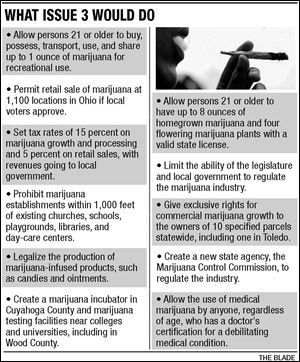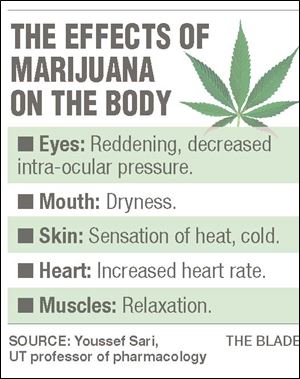Federal regulations impede research
BY MARLENE HARRIS-TAYLOR
The possible legalization of marijuana
in Ohio — Issue 3 — is one of the most controversial proposals that
voters will decide on Nov. 3.
As voters weigh their decision, many are considering the legal and health implications of removing a barrier to marijuana, while health consequences of the legalization are little understood.
The proposed constitutional amendment would legalize personal and medical use of marijuana and marijuana-infused products for people over the age of 21. It would authorize physicians to issue medical marijuana certifications to patients who suffer from certain debilitating conditions such as cancer, glaucoma, dementia, those with severe pain, and those with seizures.
Although medical marijuana is legal in different forms in 23 states, and marijuana for recreational use is legal in four states, the government and research communities have been sluggish in responding to the need for more research on the health effects, said John Hudak, a fellow at the Brookings Institution.
“There is a fear about what that change in tone might mean. The fear is if you expand research into medical marijuana that you would be attacked politically,” Mr. Hudak said.

Limited science
Of all the controlled substances, such as cocaine and heroin, the federal government regulates marijuana in unique ways that impede research. Its use for medical treatment is happening in states based largely on anecdotal or limited science, he said. The science is not very clear on the long-term effects of the drug on casual users, Mr. Hudak said.
Marijuana is still classified by the U.S. government as a Schedule 1 drug, which means it has no acceptable medicinal use and a high potential for abuse, he said.
“Marijuana is considered more dangerous than cocaine by the federal government. They say cocaine has medicinal value, but there is no research to back the claim that there is no medicinal value in marijuana,” said Mr. Hudak, who has written research papers on the issue.
He does not take a position on whether the drug should be legalized but is concerned because so many Americans have access to it and the government is not changing its policies to encourage more research, he said.
Earlier this month, a new research organization announced that it had picked central Ohio for what it says would be a $24 million flagship facility to study the effects of medical marijuana.
Garrett Greenlee, a 1990 mechanical engineering graduate of Ohio State University and founder of the International Cannabinoid Research Foundation, said having specific growing locations written into the Ohio Constitution promises stability for a controlled, long-term study.
Part of the reason that marijuana is so difficult to study is there is a complex mixture of compounds in marijuana, said Ruben Baler, health scientist with the National Institute on Drug Abuse.
“It will be extremely difficult for the FDA to ever approve a medicine that is delivered through smoke — one with the complex mixture of compounds in marijuana. Some of the compounds are toxic or carcinogenic and that cannot be the basis of a medicine,” Mr. Baler said.
The National Institute is also against the legalization of marijuana because of the fear of what will happen if the “perception of harm goes down,” he said.
“We have two legal substances, alcohol and tobacco, with health costs in the billions. We have 400,000 to 500,000 a year in deaths a year from tobacco. Do we need to add a third legal drug?” he asked.
Medical opposition
The majority of those in the Ohio medical community are almost uniformly against passage of Issue 3 based on the potential of harmful health effects. The Ohio Association of Children’s Hospitals, including ProMedica in Toledo, are opposed to the proposed constitutional amendment.
Marijuana, when smoked or ingested, creates a feeling of euphoria or makes the user high. There is clear scientific evidence that it is a mood-altering drug that affects the cognitive functions of the users, said Dr. Bruce Barnett, a pediatric pulmonologist and vice president of medical affairs at ProMedica Toledo Children’s Hospital.
“That’s your ability to think that three and three make six, not nine, that’s the problem solving or cognitive function and it certainly affects your motor function,“ Dr. Barnett said.
“As a practicing lung doctor for kids, we know that it does the same thing that smoking cigarettes does. It causes inflammation. It causes increased infection. It causes increased mucus infection. It causes increased cough,” he said.
“We don’t know whether it has increased risk for lung cancer, but it’s like smoking an unfiltered cigarette and the way people smoke it is they draw it as deeply into their lungs as they can and they hold it there as long as they can. So I would guess that some of the same tars and nicotine that are present in regular tobacco would be present in marijuana,” he added.
 Youssef Sari, associate professor of pharmacology at the University of
Toledo, fears that people who suffer from mental-health issues could
be harmed by using marijuana.
Youssef Sari, associate professor of pharmacology at the University of
Toledo, fears that people who suffer from mental-health issues could
be harmed by using marijuana.
THE BLADE/JETTA FRASER
Youssef Sari, associate professor of pharmacology at the University
of Toledo college of pharmacy said, however, that there has been much
more research on the effects of smoking tobacco than on marijuana.
“With marijuana it could be the same thing, but we just don’t know. There has not been enough research done,” he said.
Another view
“Why don’t they ban cigarettes? That kills more people than anything,” said a local physician who spoke to The Blade under the condition of anonymity.
The physician said he does not endorse the use of marijuana but said he would like to see Issue 3 approved and marijuana legalized in Ohio. The doctor said he is concerned that any physician who speaks positively about Issue 3 would be ostracized by the medical board.
“There is some concern about lung cancer and pot, but it is not proven. It’s just speculation. There are no long-term studies,” he said.
He advocates for the legalization and regulation of marijuana in Ohio to decrease the criminal element involved in the illegal sale of the drug. That would make way for it to be used for medical purposes.
“I think this is crazy, criminalizing things and forcing it underground. The occasional user is probably not going to have a problem. There are no studies to prove that either, but common experience shows that it is usually not a problem,” he said.
Other concerns
 Mr. Sari, who opposes recreational use of the drug, is in favor of
the use of medical marijuana in Ohio but only if it is tightly regulated
and the active ingredient, THC, is extracted from the plant and given
to patients.
Mr. Sari, who opposes recreational use of the drug, is in favor of
the use of medical marijuana in Ohio but only if it is tightly regulated
and the active ingredient, THC, is extracted from the plant and given
to patients.
“In some patients it does help with pain if you just use the cannabis,” he said.
He is very concerned that if the drug is legal and available in Ohio, some users will convert it to hashish, which Mr. Sari argues is the most dangerous form of the drug.
“They add chemicals to make concentrated hashish. It’s very dangerous because of those chemicals, and people abuse it and it is very addictive. Long term, it can lead to schizophrenia. There is data,” he said.
Mr. Sari and Dr. Barnett agree that legalization will make marijuana more available to people under the age of 21. This group in particular could be the most at-risk to negative effects from the drug, particularly if they start using it at an early age, they said.
The National Institute on Drug Abuse says 45 percent of 12th graders reported trying marijuana in the Monitoring the Future Study conducted in 2012. More than 4 million people, 12 and older, abused marijuana or had an addiction problem, according to the same survey.
“It is known that if you smoke heavy amounts of marijuana starting at a young age it will decrease your IQ,” Dr. Barnett said.
Marijuana can interfere with the endocannabinoid system in the brain, and one of the main functions of this system is to program the brains of adolescents, said the National Institute’s Mr. Baler.
“To what extent? It varies by individuals. Some can use a lot and it won’t affect them, but there are some who are vulnerable. Some people have bad genes and people with underlying conditions like stress or mental-health conditions are vulnerable,” he said.
Mr. Sari is also worried that people who suffer from mental-health issues could be harmed by using marijuana.
“People use it to relieve anxiety, but then long-term use, chronic use, can make the anxiety worse,” he said.
Initially they feel some relief, “they feel happy,” but it’s temporary, he said.
As voters weigh their decision, many are considering the legal and health implications of removing a barrier to marijuana, while health consequences of the legalization are little understood.
The proposed constitutional amendment would legalize personal and medical use of marijuana and marijuana-infused products for people over the age of 21. It would authorize physicians to issue medical marijuana certifications to patients who suffer from certain debilitating conditions such as cancer, glaucoma, dementia, those with severe pain, and those with seizures.
Although medical marijuana is legal in different forms in 23 states, and marijuana for recreational use is legal in four states, the government and research communities have been sluggish in responding to the need for more research on the health effects, said John Hudak, a fellow at the Brookings Institution.
“There is a fear about what that change in tone might mean. The fear is if you expand research into medical marijuana that you would be attacked politically,” Mr. Hudak said.

Of all the controlled substances, such as cocaine and heroin, the federal government regulates marijuana in unique ways that impede research. Its use for medical treatment is happening in states based largely on anecdotal or limited science, he said. The science is not very clear on the long-term effects of the drug on casual users, Mr. Hudak said.
Marijuana is still classified by the U.S. government as a Schedule 1 drug, which means it has no acceptable medicinal use and a high potential for abuse, he said.
“Marijuana is considered more dangerous than cocaine by the federal government. They say cocaine has medicinal value, but there is no research to back the claim that there is no medicinal value in marijuana,” said Mr. Hudak, who has written research papers on the issue.
He does not take a position on whether the drug should be legalized but is concerned because so many Americans have access to it and the government is not changing its policies to encourage more research, he said.
Earlier this month, a new research organization announced that it had picked central Ohio for what it says would be a $24 million flagship facility to study the effects of medical marijuana.
Garrett Greenlee, a 1990 mechanical engineering graduate of Ohio State University and founder of the International Cannabinoid Research Foundation, said having specific growing locations written into the Ohio Constitution promises stability for a controlled, long-term study.
Part of the reason that marijuana is so difficult to study is there is a complex mixture of compounds in marijuana, said Ruben Baler, health scientist with the National Institute on Drug Abuse.
“It will be extremely difficult for the FDA to ever approve a medicine that is delivered through smoke — one with the complex mixture of compounds in marijuana. Some of the compounds are toxic or carcinogenic and that cannot be the basis of a medicine,” Mr. Baler said.
The National Institute is also against the legalization of marijuana because of the fear of what will happen if the “perception of harm goes down,” he said.
“We have two legal substances, alcohol and tobacco, with health costs in the billions. We have 400,000 to 500,000 a year in deaths a year from tobacco. Do we need to add a third legal drug?” he asked.
Medical opposition
The majority of those in the Ohio medical community are almost uniformly against passage of Issue 3 based on the potential of harmful health effects. The Ohio Association of Children’s Hospitals, including ProMedica in Toledo, are opposed to the proposed constitutional amendment.
Marijuana, when smoked or ingested, creates a feeling of euphoria or makes the user high. There is clear scientific evidence that it is a mood-altering drug that affects the cognitive functions of the users, said Dr. Bruce Barnett, a pediatric pulmonologist and vice president of medical affairs at ProMedica Toledo Children’s Hospital.
“That’s your ability to think that three and three make six, not nine, that’s the problem solving or cognitive function and it certainly affects your motor function,“ Dr. Barnett said.
“As a practicing lung doctor for kids, we know that it does the same thing that smoking cigarettes does. It causes inflammation. It causes increased infection. It causes increased mucus infection. It causes increased cough,” he said.
“We don’t know whether it has increased risk for lung cancer, but it’s like smoking an unfiltered cigarette and the way people smoke it is they draw it as deeply into their lungs as they can and they hold it there as long as they can. So I would guess that some of the same tars and nicotine that are present in regular tobacco would be present in marijuana,” he added.
 Youssef Sari, associate professor of pharmacology at the University of
Toledo, fears that people who suffer from mental-health issues could
be harmed by using marijuana.
Youssef Sari, associate professor of pharmacology at the University of
Toledo, fears that people who suffer from mental-health issues could
be harmed by using marijuana.THE BLADE/JETTA FRASER
“With marijuana it could be the same thing, but we just don’t know. There has not been enough research done,” he said.
Another view
“Why don’t they ban cigarettes? That kills more people than anything,” said a local physician who spoke to The Blade under the condition of anonymity.
The physician said he does not endorse the use of marijuana but said he would like to see Issue 3 approved and marijuana legalized in Ohio. The doctor said he is concerned that any physician who speaks positively about Issue 3 would be ostracized by the medical board.
“There is some concern about lung cancer and pot, but it is not proven. It’s just speculation. There are no long-term studies,” he said.
He advocates for the legalization and regulation of marijuana in Ohio to decrease the criminal element involved in the illegal sale of the drug. That would make way for it to be used for medical purposes.
“I think this is crazy, criminalizing things and forcing it underground. The occasional user is probably not going to have a problem. There are no studies to prove that either, but common experience shows that it is usually not a problem,” he said.
 Mr. Sari, who opposes recreational use of the drug, is in favor of
the use of medical marijuana in Ohio but only if it is tightly regulated
and the active ingredient, THC, is extracted from the plant and given
to patients.
Mr. Sari, who opposes recreational use of the drug, is in favor of
the use of medical marijuana in Ohio but only if it is tightly regulated
and the active ingredient, THC, is extracted from the plant and given
to patients.“In some patients it does help with pain if you just use the cannabis,” he said.
He is very concerned that if the drug is legal and available in Ohio, some users will convert it to hashish, which Mr. Sari argues is the most dangerous form of the drug.
“They add chemicals to make concentrated hashish. It’s very dangerous because of those chemicals, and people abuse it and it is very addictive. Long term, it can lead to schizophrenia. There is data,” he said.
Mr. Sari and Dr. Barnett agree that legalization will make marijuana more available to people under the age of 21. This group in particular could be the most at-risk to negative effects from the drug, particularly if they start using it at an early age, they said.
The National Institute on Drug Abuse says 45 percent of 12th graders reported trying marijuana in the Monitoring the Future Study conducted in 2012. More than 4 million people, 12 and older, abused marijuana or had an addiction problem, according to the same survey.
“It is known that if you smoke heavy amounts of marijuana starting at a young age it will decrease your IQ,” Dr. Barnett said.
Marijuana can interfere with the endocannabinoid system in the brain, and one of the main functions of this system is to program the brains of adolescents, said the National Institute’s Mr. Baler.
“To what extent? It varies by individuals. Some can use a lot and it won’t affect them, but there are some who are vulnerable. Some people have bad genes and people with underlying conditions like stress or mental-health conditions are vulnerable,” he said.
Mr. Sari is also worried that people who suffer from mental-health issues could be harmed by using marijuana.
“People use it to relieve anxiety, but then long-term use, chronic use, can make the anxiety worse,” he said.
Initially they feel some relief, “they feel happy,” but it’s temporary, he said.

No comments:
Post a Comment